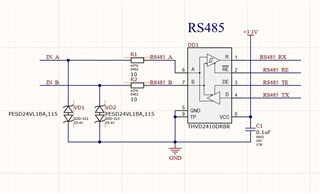Hello, I have a problam with your RS485 driver: THVD2410DRBR. Below I give part of my circuit. All 4 output pin conected to a outer conectors. There are 4 wires on the line to the sensor: power, ground, A and B. The power line is +24 V. The user can accidentally mix up the wires and connect erroneously to line A or B to +24 V, and connected +24 V line to line A or B . The datasheet says that the driver can withstand the voltage on lines A and B up to 25 V (typically), and up to a maximum of 70 V (as I understand it, this is to protect against switching currents). During our tests of such an incorrect connections, there are times when the driver had broken. I would like to clarify why this is happening? Maybe I did not understand something in the documentation or interpreted it incorrectly?




